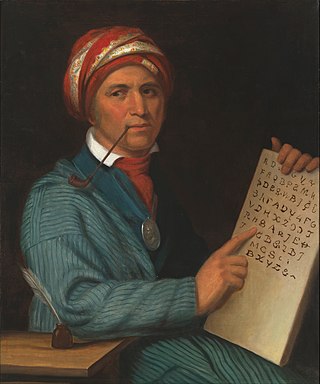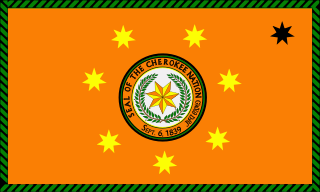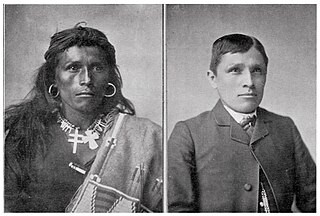
The Cherokee people are one of the Indigenous peoples of the Southeastern Woodlands of the United States. Prior to the 18th century, they were concentrated in their homelands, in towns along river valleys of what is now southwestern North Carolina, southeastern Tennessee, southwestern Virginia, edges of western South Carolina, northern Georgia and northeastern Alabama consisting of around 40,000 square miles

Indian Territory and the Indian Territories are terms that generally described an evolving land area set aside by the United States government for the relocation of Native Americans who held original Indian title to their land as an independent nation-state. The concept of an Indian territory was an outcome of the U.S. federal government's 18th- and 19th-century policy of Indian removal. After the American Civil War (1861–1865), the policy of the U.S. government was one of assimilation.

Tribal sovereignty in the United States is the concept of the inherent authority of Indigenous tribes to govern themselves within the borders of the United States.
Oliphant v. Suquamish Indian Tribe, 435 U.S. 191 (1978), is a United States Supreme Court case deciding that Indian tribal courts have no criminal jurisdiction over non-Indians. The case was decided on March 6, 1978 with a 6–2 majority. The court opinion was written by William Rehnquist, and a dissenting opinion was written by Thurgood Marshall, who was joined by Chief Justice Warren Burger. Justice William J. Brennan did not participate in the decision.

Henry Baldwin was an American judge who was an Associate Justice of the Supreme Court of the United States from January 6, 1830, to April 21, 1844.

The United Keetoowah Band of Cherokee Indians in Oklahoma is a federally recognized tribe of Cherokee Native Americans headquartered in Tahlequah, Oklahoma. According to the UKB website, its members are mostly descendants of "Old Settlers" or "Western Cherokees," those Cherokees who migrated from the Southeast to present-day Arkansas and Oklahoma around 1817. Some reports estimate that Old Settlers began migrating west by 1800, before the forced relocation of Cherokees by the United States in the late 1830s under the Indian Removal Act.

The Cherokee Nation, formerly known as the Cherokee Nation of Oklahoma, is the largest of three federally recognized tribes of Cherokees in the United States. It includes people descended from members of the Old Cherokee Nation who relocated, due to increasing pressure, from the Southeast to Indian Territory and Cherokees who were forced to relocate on the Trail of Tears. The tribe also includes descendants of Cherokee Freedmen, Absentee Shawnee, and Natchez Nation. As of 2023, over 450,000 people were enrolled in the Cherokee Nation.
The Goingsnake Massacre refers to the eleven victims of a fatal shootout on April 15, 1872, that broke out during a murder and assault trial in the Cherokee court in the Goingsnake District of the Cherokee Nation The dead included three Cherokee on the defendant's side, including his attorney and a brother; a US Deputy Marshal and four members of his federal posse, plus three relatives of the Cherokee murder victim. Another ten men were wounded, including both Cherokee and white men.

A series of efforts were made by the United States to assimilate Native Americans into mainstream European–American culture between the years of 1790 and 1920. George Washington and Henry Knox were first to propose, in the American context, the cultural assimilation of Native Americans. They formulated a policy to encourage the so-called "civilizing process". With increased waves of immigration from Europe, there was growing public support for education to encourage a standard set of cultural values and practices to be held in common by the majority of citizens. Education was viewed as the primary method in the acculturation process for minorities.
The Cherokee Freedmen controversy was a political and tribal dispute between the Cherokee Nation of Oklahoma and descendants of the Cherokee Freedmen regarding the issue of tribal membership. The controversy had resulted in several legal proceedings between the two parties from the late 20th century to August 2017.

Native American recognition in the United States, for tribes, usually means being recognized by the United States federal government as a community of Indigenous people that has been in continual existence since prior to European contact, and which has a sovereign, government-to-government relationship with the Federal government of the United States. In the United States, the Native American tribe is a fundamental unit of sovereign tribal government. This recognition comes with various rights and responsibilities. The United States recognizes the right of these tribes to self-government and supports their tribal sovereignty and self-determination. These tribes possess the right to establish the legal requirements for membership. They may form their own government, enforce laws, tax, license and regulate activities, zone, and exclude people from tribal territories. Limitations on tribal powers of self-government include the same limitations applicable to states; for example, neither tribes nor states have the power to make war, engage in foreign relations, or coin money.

John Jolly was a leader of the Cherokee in Tennessee, the Arkansaw district of the Missouri Territory, and Indian Territory. After a reorganization of the tribal government around 1818, he was made Principal Chief of the Cherokee Nation–West. Jolly was a wealthy slave-owning planter, cow rancher, and merchant. In many ways, he lived the life of a Southern planter.
The Cherokee Male Seminary was a tribal college established in 1846 by the Cherokee Nation in Indian Territory. Opening in 1851, it was one of the first institutions of higher learning in the United States to be founded west of the Mississippi River.
Fellows v. Blacksmith, 60 U.S. 366 (1857), is a United States Supreme Court decision involving Native American law. John Blacksmith, a Tonawanda Seneca, sued agents of the Ogden Land Company for common law claims of trespass, assault, and battery after he was forcibly evicted from his sawmill by the Company's agents. The Court affirmed a judgement in Blacksmith's favor, notwithstanding the fact that the Seneca had executed an Indian removal treaty and the Company held the exclusive right to purchase to the land by virtue of an interstate compact ratified by Congress.

The Supreme Court of the United States, under Chief Justice Roger B. Taney (1836–1864), issued several important decisions on the status of aboriginal title in the United States, building on the opinions of aboriginal title in the Marshall Court.
The following outline is provided as an overview of and topical guide to United States federal Indian law and policy:

The Taney Court heard thirty criminal law cases, approximately one per year. Notable cases include Prigg v. Pennsylvania (1842), United States v. Rogers (1846), Ableman v. Booth (1858), Ex parte Vallandigham (1861), and United States v. Jackalow (1862).
Williams v. Lee, 358 U.S. 217 (1959), was a landmark case in which the Supreme Court of the United States held that the State of Arizona does not have jurisdiction to try a civil case between a non-Indian doing business on a reservation with tribal members who reside on the reservation, the proper forum for such cases being the tribal court.
United States v. Ramsey, 271 U.S. 467 (1926), was a U.S. Supreme Court case in which the Court held that the government had the authority to prosecute crimes against Native Americans (Indians) on reservation land that was still designated Indian Country by federal law. The Osage Indian Tribe held mineral rights that were worth millions of dollars. A white rancher, William K. Hale, devised a plot to kill tribal members to allow his nephew, who was married to a tribal member, to inherit the mineral rights. The tribe requested the assistance of the federal government, which sent Bureau of Investigation agents to solve the murders. Hale and several others were arrested and tried for the murders, but they claimed that the federal government did not have jurisdiction. The district court quashed the indictments, but on appeal, the Supreme Court reversed, holding that the Osage lands were Indian Country and that the federal government therefore had jurisdiction. This put an end to the Osage Indian murders.
United States v. Antelope, 430 U.S. 641 (1977), was a United States Supreme Court case in which the Court held that American Indians convicted on reservation land were not deprived of the equal protection of the laws; (a) the federal criminal statutes are not based on impermissible racial classifications but on political membership in an Indian tribe or nation; and (b) the challenged statutes do not violate equal protection. Indians or non-Indians can be charged with first-degree murder committed in a federal enclave.












